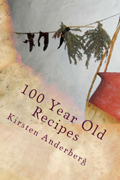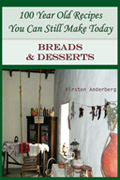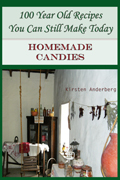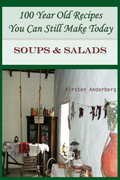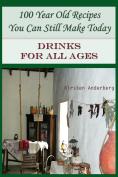Kirsten Anderberg's URBAN ADVENTURES:
San Fernando Mission
The San Fernando Mission is located in the northern end of the San Fernando Valley in Los Angeles County, CA. It is a few blocks south of Rinaldi, and a few blocks east of Sepulveda Blvd, at
15151 San Fernando Mission Blvd. in Mission Hills. (Phone: (818) 361-0186) The mission was built in 1797, and went through several different occupations and ownerships, until President Lincoln restored
the mission to the Catholic Church in 1862. It has suffered damages several times during the earthquakes of 1812, 1971 and also 1994.
The Mission buildings themselves are beautiful and cool even on a hot day. The white adobe walls and red tile roofs do endow places with a quaint ambiance,
especially when banana and fan palms
and fountains grace the area as well. I love the Mission grounds, the buildings are beautiful and the peacocks and gardens are calming.
In Bess Cleveland's out of print book, California Mission Recipes San Fernando Mission Hot Chocolate
Mix the cocoa, sugar, salt, and hot water. Cook about 3 minutes, add scalded milk, and cool to boiling point but DO NOT allow to boil. Add beaten egg, vanilla, and dash of nutmeg or cinnamon to taste and
beat into the hot chocolate, then serve. Makes 2 servings.
Critics of the Mission exist as well. Its history is still not that well known, to be honest. Here is some critique by Mike Davis...
In Mike Davis' book, "City of Quartz," he writes, "...the Monsignor (Francis Weber) has devoted much of his life to sketching idealized vignettes of the early California church. Although
the forced labor system of the original Franciscan missions was tantamount to slavery (as California Indian leaders have recently reminded the Church), Monsignor Weber - a leading crusader
for the canonization of Father Serra - defends a vision of gentle padres and their happy neophytes...a romance that generations of tourists and white Angelenos have confused with real history. It is no
accident that the church still relies upon the "Mission Myth" as a buffer between itself and its past."
Davis also writes, "The mission literature depicted the history of race relations as a pastoral ritual of obedience and paternalism: 'graceful Indians, happy as
peasants in an Italian opera, knelt dutifully before the Franciscans to receive the baptism of a superior culture, while in the background the angelus tolled from a swallow-guarded campanile,
and a choir of friars intoned the Te Deum.' Any intimation of the brutality inherent in the forced labor system of the missions and haciendas, not to speak of the racial terrorism and lynchings
that made early Anglo-ruled Los Angeles the most violent town in the West during the 1860's and 1870's, was suppressed." He then quotes Joseph O'Flaherty; "The romanticized and idyllic theme
was quickly picked up and exploited by a gallery of entrepreneurs who knew a good thing when they saw it. Everything from furniture suites and candied fruit to commercial and residential
architecture stressed the mission motif."
Davis notes that "some of the missions themselves were restored as pioneer theme parks...At a New York advertising convention in the early 1930's, the mission aura of 'history and romance'
was rated as an even more important attraction in selling Southern California than weather or movie-industry glamor. Of course, as Starr notes, this capitalization of Los Angeles's fictional
"Spanish" past not only sublimated contemporary class struggle, but also censored, and repressed from view, the actual plight of Alta California's descendants....
(Contemporary mini-malls and fastfood franchises, with their Franciscan arches and red-tiled roofs, are still quoting chapter and verse from the Mission Myth...)"
 The Mission church and workshop buildings (Photo: K.Anderberg, Jan. 2008)
The Mission church and workshop buildings (Photo: K.Anderberg, Jan. 2008)
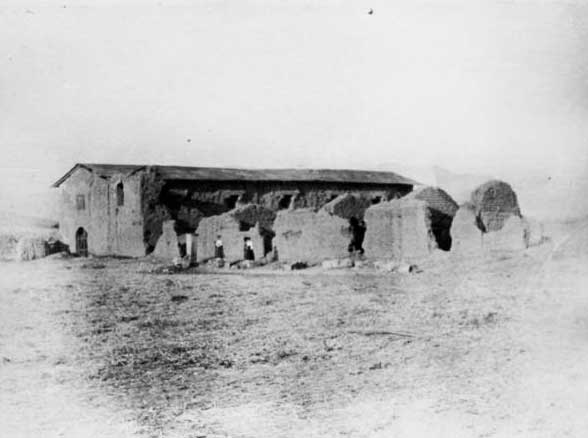 This is an undated archival photo of the same area as the previous photo, in the early 1900's, most probably, when it was falling apart. (From the San Fernando Valley History Digital Library)
This is an undated archival photo of the same area as the previous photo, in the early 1900's, most probably, when it was falling apart. (From the San Fernando Valley History Digital Library)
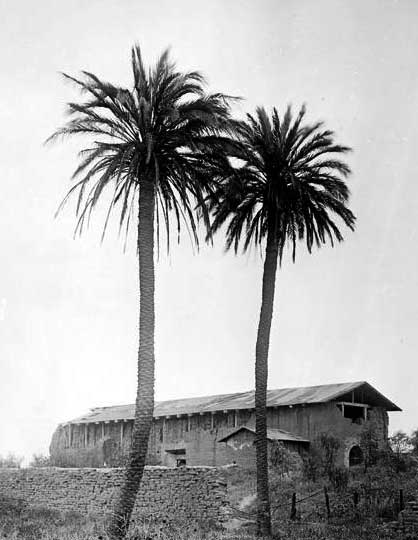 The Mission Church as it was falling apart due to the elements...the north and east doors to the church are shown in this photo. This photo is from an unknown photographer and it has no date. It is from the
West Valley Museum Archives.
The Mission Church as it was falling apart due to the elements...the north and east doors to the church are shown in this photo. This photo is from an unknown photographer and it has no date. It is from the
West Valley Museum Archives.
 The back (north) door of the San Fernando Mission Chapel, looking out towards the Memorial Garden. In the previous photo, this door is in between the two palm trees. (Photo: K.Anderberg, Jan. 2008)
The back (north) door of the San Fernando Mission Chapel, looking out towards the Memorial Garden. In the previous photo, this door is in between the two palm trees. (Photo: K.Anderberg, Jan. 2008)
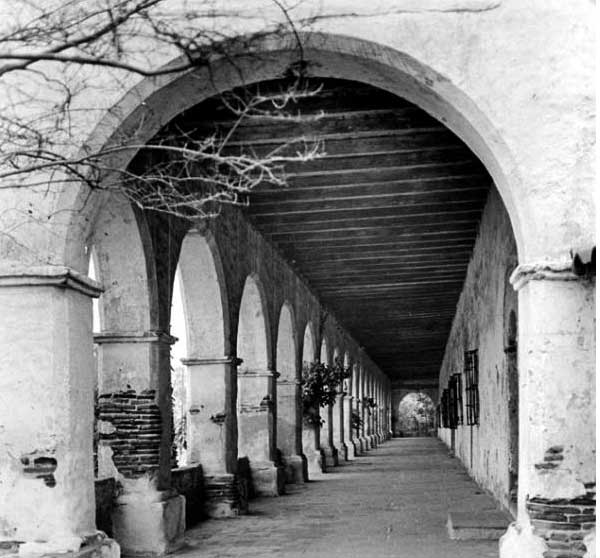 The Mission arches on the front of the convento building, as it looked in 1897. This photo is from the archives of Milt Fries.
The Mission arches on the front of the convento building, as it looked in 1897. This photo is from the archives of Milt Fries.
 The San Fernando Mission as it looked in 1912. This photo is from the San Fernando Valley History Digital Library.
The San Fernando Mission as it looked in 1912. This photo is from the San Fernando Valley History Digital Library.
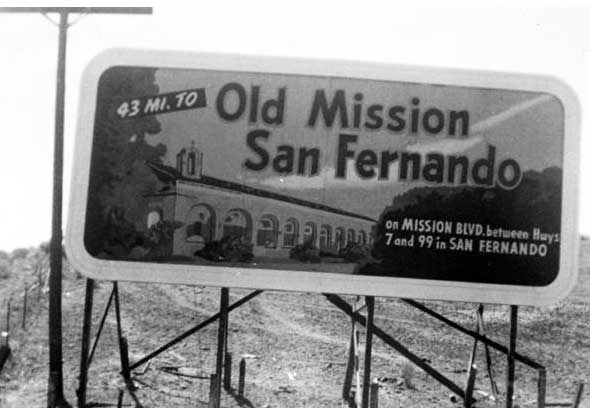 A San Fernando Mission billboard circa 1961. This photo is from the San Fernando Valley History Digital Library.
A San Fernando Mission billboard circa 1961. This photo is from the San Fernando Valley History Digital Library.
 The convento building which was used as an inn, of sorts (Photo: K.Anderberg, Jan. 2008)
The convento building which was used as an inn, of sorts (Photo: K.Anderberg, Jan. 2008)
 One of the bedrooms in the Convento building (Photo: K.Anderberg, Jan. 2008)
One of the bedrooms in the Convento building (Photo: K.Anderberg, Jan. 2008)
(1984, Charles E. Tuttle Company Publishers, Rutland, VT), she writes that hot chocolate was one of the padres' favorite drinks, and says
that cocoa and chocolate were brought to the mission from supply ships. She also wrote that the padres came from Mexico where hot chocolate was a favored beverage. Her book
gives 4 hot chocolate recipes that she attributes to the San Fernando Mission. I have included one below:
1 Tablespoon cocoa or grated chocolate * 3 teaspoons sugar * dash of salt * 1 cup hot water *
1 1/2 cups milk, scalded * 1 egg, well beaten * 1 teaspoon vanilla * Nutmeg or cinnamon
 A table inside the Majordomo building (Photo: K.Anderberg, Jan. 2008)
A table inside the Majordomo building (Photo: K.Anderberg, Jan. 2008)
 One of the hospice rooms in the Convento building (Photo: K.Anderberg, Jan. 2008)
One of the hospice rooms in the Convento building (Photo: K.Anderberg, Jan. 2008)
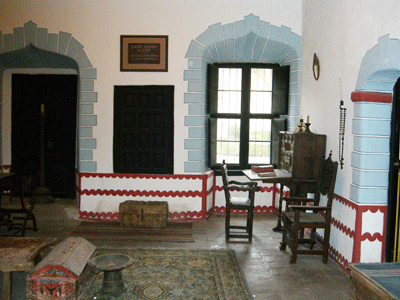 Another room in the Convento building (Photo: K.Anderberg, Jan. 2008)
Another room in the Convento building (Photo: K.Anderberg, Jan. 2008)
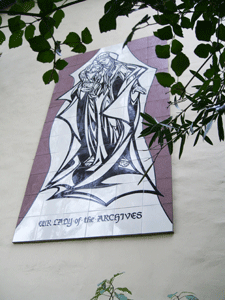 The Mission houses some very interesting archives pertaining to the San Fernando Valley and its history. This tilework
dedicated to "Our Lady of the Archives" hangs on the outside wall of the archive building at the Mission. (Photo: K.Anderberg, Jan. 2008)
The Mission houses some very interesting archives pertaining to the San Fernando Valley and its history. This tilework
dedicated to "Our Lady of the Archives" hangs on the outside wall of the archive building at the Mission. (Photo: K.Anderberg, Jan. 2008)
Thank you to Resist.ca for hosting this website!



